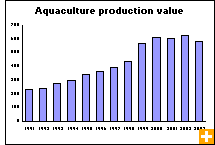Common menu bar links
From fishing to aquaculture
Archived Content
Information identified as archived is provided for reference, research or recordkeeping purposes. It is not subject to the Government of Canada Web Standards and has not been altered or updated since it was archived. Please contact us to request a format other than those available.
In the late 1600s, fishermen caught an estimated 100,000 metric tonnes of cod each year in the waters off Newfoundland and Labrador. During the 1960s, the size of these annual catches peaked at 2 million tonnes annually. In the years that followed, however, what was once thought to be an inexhaustible supply of wild fish began to quickly decline.
Over-fishing has affected many species, driving some to the brink of extinction. The use of modern fishing tools, such as Global Positioning Systems for navigation, sonars for locating fish and high-efficiency trawlers for netting fish are partly to blame. To protect certain species from over-fishing, the government established quotas for the Atlantic fishery in the early 1990s.
As wild stocks declined, aquaculture has become an attractive alternative. Commercial aquaculture production in Canada dates back to the 1950s, when trout and oysters were the major species cultivated. In the ensuing decades, the industry has expanded into two distinct branches: one for finfish, like salmon and trout, and another for shellfish, such as mussels and clams.
 Aquaculture has benefited from the quotas on wild fish. In 1990, before quotas were imposed, the aquaculture industry produced 36,462 tonnes of fish. By 2003, aquaculture output had more than quadrupled, producing 155,634 tonnes.
Aquaculture has benefited from the quotas on wild fish. In 1990, before quotas were imposed, the aquaculture industry produced 36,462 tonnes of fish. By 2003, aquaculture output had more than quadrupled, producing 155,634 tonnes.
Despite the large increases in aquaculture production, wild stocks remain the major source of income for the fishing industry. Since a limited number of species can be farmed successfully, in 2003, aquaculture accounted for only 8% of the volume of the Atlantic fishery. Thanks to scientific advances, however, aquaculture is still growing in importance as a method of fishing.


